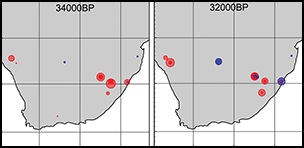Crossref Citations
This article has been cited by the following publications. This list is generated based on data provided by
Crossref.
Loftus, Emma
Pargeter, Justin
Mackay, Alex
Stewart, Brian A.
and
Mitchell, Peter
2019.
Late Pleistocene human occupation in the Maloti-Drakensberg region of southern Africa: New radiocarbon dates from Rose Cottage Cave and inter-site comparisons.
Journal of Anthropological Archaeology,
Vol. 56,
Issue. ,
p.
101117.
Bronk Ramsey, Christopher
Blaauw, Maarten
Kearney, Rebecca
and
Staff, Richard A
2019.
The Importance of Open Access to Chronological Information: The IntChron Initiative.
Radiocarbon,
Vol. 61,
Issue. 5,
p.
1121.
Capuzzo, Giacomo
Snoeck, Christophe
Boudin, Mathieu
Dalle, Sarah
Annaert, Rica
Hlad, Marta
Kontopoulos, Ioannis
Sabaux, Charlotte
Salesse, Kevin
Sengeløv, Amanda
Stamataki, Elisavet
Veselka, Barbara
Warmenbol, Eugène
De Mulder, Guy
Tys, Dries
and
Vercauteren, Martine
2020.
CREMATION VS. INHUMATION: MODELING CULTURAL CHANGES IN FUNERARY PRACTICES FROM THE MESOLITHIC TO THE MIDDLE AGES IN BELGIUM USING KERNEL DENSITY ANALYSIS ON14C DATA.
Radiocarbon,
Vol. 62,
Issue. 6,
p.
1809.
Mazzucco, Niccolò
Ibáñez, Juan José
Capuzzo, Giacomo
Gassin, Bernard
Mineo, Mario
Gibaja, Juan Francisco
and
Biehl, Peter F.
2020.
Migration, adaptation, innovation: The spread of Neolithic harvesting technologies in the Mediterranean.
PLOS ONE,
Vol. 15,
Issue. 4,
p.
e0232455.
Wurz, S.
2021.
Technocomplexes and chronostratigraphy for MIS 6-1 in southern Africa.
South African Journal of Geology,
Vol. 124,
Issue. 4,
p.
1083.
Hajdas, Irka
Ascough, Philippa
Garnett, Mark H.
Fallon, Stewart J.
Pearson, Charlotte L.
Quarta, Gianluca
Spalding, Kirsty L.
Yamaguchi, Haruka
and
Yoneda, Minoru
2021.
Radiocarbon dating.
Nature Reviews Methods Primers,
Vol. 1,
Issue. 1,
Seidensticker, Dirk
Hubau, Wannes
Verschuren, Dirk
Fortes-Lima, Cesar
de Maret, Pierre
Schlebusch, Carina M.
and
Bostoen, Koen
2021.
Population collapse in Congo rainforest from 400 CE urges reassessment of the Bantu Expansion.
Science Advances,
Vol. 7,
Issue. 7,
Ward, Ingrid
and
Larcombe, Piers
2021.
Sedimentary unknowns constrain the current use of frequency analysis of radiocarbon data sets in forming regional models of demographic change.
Geoarchaeology,
Vol. 36,
Issue. 3,
p.
546.
Lombard, Marlize
Lotter, Matt G.
van der Walt, Jaco
and
Caruana, Matthew V.
2021.
The Keimoes kite landscape of the trans-Gariep, South Africa.
Archaeological and Anthropological Sciences,
Vol. 13,
Issue. 6,
Stratford, D.
Braun, K.
and
Morrissey, P.
2021.
Cave and rock shelter sediments of southern Africa: a review of the chronostratigraphic and palaeoenvironmental record from Marine Isotope Stage 6 to 1.
South African Journal of Geology,
Vol. 124,
Issue. 4,
p.
879.
Avery, D.M.
2021.
Micromammals and the Late Quaternary of southern Africa.
South African Journal of Geology,
Vol. 124,
Issue. 4,
p.
1073.
Woor, Sam
Buckland, Catherine
Parton, Ash
and
Thomas, David S.G.
2022.
Assessing the robustness of geochronological records from the Arabian Peninsula: A new synthesis of the last 20 ka.
Global and Planetary Change,
Vol. 209,
Issue. ,
p.
103748.
Ramstein, Marianne
Steuri, Noah
Brönnimann, David
Rentzel, Philippe
Cornelissen, Marcel
Schimmelpfennig, Dirk
Anselmetti, Flavio S.
Häberle, Simone
Vandorpe, Patricia
Siebke, Inga
Furtwängler, Anja
Szidat, Sönke
Hafner, Albert
Krause, Johannes
and
Lösch, Sandra
2022.
The well-preserved Late Neolithic dolmen burial of Oberbipp, Switzerland. Construction, use, and post-depositional processes.
Journal of Archaeological Science: Reports,
Vol. 42,
Issue. ,
p.
103397.
Davies, Benjamin
Power, Mitchell J.
Braun, David R.
Douglass, Matthew J.
Mosher, Stella G.
Quick, Lynne J.
Esteban, Irene
Sealy, Judith
Parkington, John
and
Faith, J. Tyler
2022.
Fire and human management of late Holocene ecosystems in southern Africa.
Quaternary Science Reviews,
Vol. 289,
Issue. ,
p.
107600.
Pacchiarotti, Sara
and
Bostoen, Koen
2022.
Erratic velars in West-Coastal Bantu.
Journal of Historical Linguistics,
Vol. 12,
Issue. 3,
p.
381.
Hallinan, Emily
2022.
Landscape-scale perspectives on Later Stone Age settlement in the Tankwa Karoo, South Africa.
Azania: Archaeological Research in Africa,
Vol. 57,
Issue. 4,
p.
419.
Clist, Bernard
Denbow, James
and
Lanfranchi, Raymond
2023.
Using the radiocarbon dates of Central Africa for studying long-term demographic trends of the last 50,000 years: potential and pitfalls.
Azania: Archaeological Research in Africa,
Vol. 58,
Issue. 2,
p.
235.
Griffiths, Seren
Brown, Lisa
Carlin, Neil
Evans, Tim
Gaydarska, Bisserka
Hannah, Emma
and
McKeague, Peter
2023.
RADIOCARBON, BIG DATA AND INTERNATIONAL HERITAGE.
Radiocarbon,
p.
1.
Steuri, Noah
Milella, Marco
Martinet, Francesca
Raiteri, Luca
Szidat, Sönke
Lösch, Sandra
and
Hafner, Albert
2023.
FIRST RADIOCARBON DATING OF NEOLITHIC STONE CIST GRAVES FROM THE AOSTA VALLEY (ITALY): INSIGHTS INTO THE CHRONOLOGY AND BURIAL RITES OF THE WESTERN ALPINE REGION.
Radiocarbon,
Vol. 65,
Issue. 2,
p.
521.
Loftus, Emma
and
Pfeiffer, Susan
2023.
Cultural Disruption Suggested by Dates of Late Holocene Burials, Southwestern Cape, South Africa.
Current Anthropology,
Vol. 64,
Issue. 4,
p.
454.



